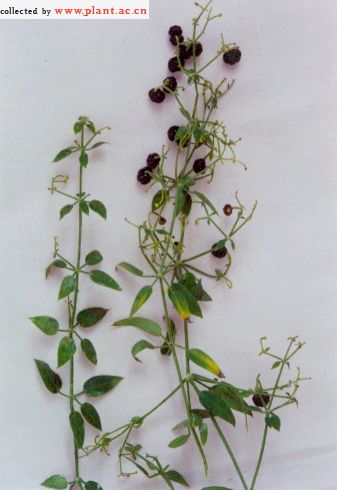中国茜草Rubia chinensis Regel et Maack
中国茜草Rubia chinensis Regel et Maack
18. 中国茜草(内蒙古植物志)大砧草(东北),木达地音一马日那(蒙古语)图版66: 8-13
Rubia chinensis Regel et Maack in Regel, Tent. Fl. Ussur. 76. no. 241, t. 8. f. 1 et 2. 1861; Maxim. in Mel. Biol. 9: 266. 1874; Hemsl. in Journ. Linn. Soc. Bot. 23: 392. 1888; kitagawa, Lineam. Fl. Mansh. 405. 1939; Pojark. in Fl. URSS 23: 291. 1958; 东北植物检索表351, 图120 (11). 1959; 内蒙古植物志5: 333, 图134 (1-2). 1980. ——R. mitis Miq. in Ann. Mus. Bot. Lugd. -Bat. 3: 122. 1867.
《Flora of China》 Vol. 19 (2011)
Rubia chinensis Regel & Maack in Regel Tent. Fl. Ussur. 76. 1861.
中国茜草 zhong guo qian cao
Herbs, perennial, rhizomatous; stems erect, to 60 cm tall, solitary or usually grouped, unbranched or few branched, quadrangular, glabrous to pilosulous at least near nodes, ribs rounded, smooth to sparsely scaberulous. Leaves in whorls of 4; petiole (0.3-)0.5-2 cm; blade drying thinly papery, ovate, oblong-ovate, or broadly elliptic, 3-10 × 1.2-4.5 cm, length/ breadth index 1.8-2.3, adaxially subglabrous and scaberulous, abaxially glabrous to pilosulous, base obtuse, rounded, or cordulate, margin scaberulous to ciliate, apex acute or acuminate; principal veins 5 or 7, palmate. Inflorescences thyrsoid, terminal and axillary in upper nodes, paniculate, many flowered, 5-30 cm, glabrous to pilosulous; axes scaberulous to smooth; bracts lanceolate, 1.5-8 mm; pedicels 2-7 mm. Ovary ca. 0.8 mm, smooth to scaberulous. Corolla greenish white, rotate, 3-4 mm in diam., glabrous, with fused base 0.2-0.6 mm; lobes 5, lanceolate, 1.7-2 mm, acute to caudate. Mericarp berry black, ca. 4 mm in diam., smooth. Fl. May-Jul, fr. Sep-Oct.
Forests on mountains, forest margins, meadows; 200-1400 m. E and N China [Japan, Korea, Russia].
Rubia chinensis and a few related species with erect (not climbing) stems and broad leaves with short petioles have been placed by Pojarkova (Fl. URSS 23: 391-392. 1958) into R. ser. Chinenses. Other Chinese species of this group include the closely related R. latipetala and R. schumanniana. The R. mandersii species group (see there) is similar but has sessile leaves.Rubia chinensis and a few related species with erect (not climbing) stems and broad leaves with short petioles have been placed by Pojarkova (Fl. URSS 23: 391-392. 1958) into R. ser. Chinenses. Other Chinese species of this group include the closely related R. latipetala and R. schumanniana. The R. mandersii species group (see there) is similar but has sessile leaves.
别名:挂拉豆;华茜草;大粘草;中华茜草;道木达地音-马日那;拉拉秧子;娘娘全;茜草;大砧草;疔毒草;
科名:茜草科 Rubiaceae
属名:茜草属 Rubia

18. 中国茜草(内蒙古植物志)大砧草(东北),木达地音一马日那(蒙古语)图版66: 8-13
Rubia chinensis Regel et Maack in Regel, Tent. Fl. Ussur. 76. no. 241, t. 8. f. 1 et 2. 1861; Maxim. in Mel. Biol. 9: 266. 1874; Hemsl. in Journ. Linn. Soc. Bot. 23: 392. 1888; kitagawa, Lineam. Fl. Mansh. 405. 1939; Pojark. in Fl. URSS 23: 291. 1958; 东北植物检索表351, 图120 (11). 1959; 内蒙古植物志5: 333, 图134 (1-2). 1980. ——R. mitis Miq. in Ann. Mus. Bot. Lugd. -Bat. 3: 122. 1867.
《Flora of China》 Vol. 19 (2011)
Rubia chinensis Regel & Maack in Regel Tent. Fl. Ussur. 76. 1861.
中国茜草 zhong guo qian cao
Herbs, perennial, rhizomatous; stems erect, to 60 cm tall, solitary or usually grouped, unbranched or few branched, quadrangular, glabrous to pilosulous at least near nodes, ribs rounded, smooth to sparsely scaberulous. Leaves in whorls of 4; petiole (0.3-)0.5-2 cm; blade drying thinly papery, ovate, oblong-ovate, or broadly elliptic, 3-10 × 1.2-4.5 cm, length/ breadth index 1.8-2.3, adaxially subglabrous and scaberulous, abaxially glabrous to pilosulous, base obtuse, rounded, or cordulate, margin scaberulous to ciliate, apex acute or acuminate; principal veins 5 or 7, palmate. Inflorescences thyrsoid, terminal and axillary in upper nodes, paniculate, many flowered, 5-30 cm, glabrous to pilosulous; axes scaberulous to smooth; bracts lanceolate, 1.5-8 mm; pedicels 2-7 mm. Ovary ca. 0.8 mm, smooth to scaberulous. Corolla greenish white, rotate, 3-4 mm in diam., glabrous, with fused base 0.2-0.6 mm; lobes 5, lanceolate, 1.7-2 mm, acute to caudate. Mericarp berry black, ca. 4 mm in diam., smooth. Fl. May-Jul, fr. Sep-Oct.
Forests on mountains, forest margins, meadows; 200-1400 m. E and N China [Japan, Korea, Russia].
Rubia chinensis and a few related species with erect (not climbing) stems and broad leaves with short petioles have been placed by Pojarkova (Fl. URSS 23: 391-392. 1958) into R. ser. Chinenses. Other Chinese species of this group include the closely related R. latipetala and R. schumanniana. The R. mandersii species group (see there) is similar but has sessile leaves.Rubia chinensis and a few related species with erect (not climbing) stems and broad leaves with short petioles have been placed by Pojarkova (Fl. URSS 23: 391-392. 1958) into R. ser. Chinenses. Other Chinese species of this group include the closely related R. latipetala and R. schumanniana. The R. mandersii species group (see there) is similar but has sessile leaves.

